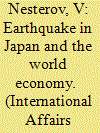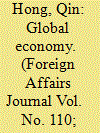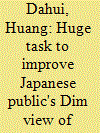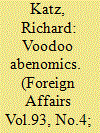|
|
|
Sort Order |
|
|
|
Items / Page
|
|
|
|
|
|
|
| Srl | Item |
| 1 |
ID:
039076


|
|
|
|
|
| Publication |
New York, Franklin Watts, Inc., 1964.
|
| Description |
89p.Hbk
|
| Series |
Military History of World War II
|
| Contents |
Vol. XIV
|
|
|
|
|
|
|
|
|
|
|
|
Copies: C:1/I:0,R:0,Q:0
Circulation
| Accession# | Call# | Current Location | Status | Policy | Location |
| 008106 | 940.54/DUP 008106 | Main | On Shelf | General | |
|
|
|
|
| 2 |
ID:
140684


|
|
|
|
|
| Summary/Abstract |
“Is Japan back?” Economically, the evidence is mixed at best due largely to slowness in carrying out vital structural reforms. In electoral terms, the Liberal Democratic Party has regained much of its prior dominance under Abe Shinzo. Most problematic of all, Japan is not back at all in regaining a commanding position within East Asia, in part due to its slow economic transformation, but due also to the atavistic positions taken by Abe’s government on the historical interpretations of Japanese behavior in World War II. KEYWORDS: Abe, Abenomics, structural reform, Liberal Democratic Party, Asian regionalism.
|
|
|
|
|
|
|
|
|
|
|
|
|
|
|
|
| 3 |
ID:
133468


|
|
|
|
|
| Publication |
2014.
|
| Summary/Abstract |
This article examines the Japanese cat café boom, which peaked in 2009 yet remains a significant retail phenomenon throughout Japan, and in particular Tokyo. How do humans encounter animals in contemporary Japan, not as private owners and companions, but as consumers seeking direct, sensory engagement with cats at a moment of profound social and economic anxieties? Drawing on ethnographic fieldwork conducted in Tokyo, this article examines how cats have become a newly emergent commodity within the 'healing boom' that first emerged in recessionary-era 1990s Japan. Such healing commodities - therapeutic music, aromatherapy, robot interaction, among others - are designed to invoke an affective engagement with the consumer in order to cope with the uncertain and stressful conditions of life in still recessionary, and now post 3/11, Japan. I situate cat cafés within the increasing immaterialization of the economy in post-bubble Japan during which social relationships have become commodified and marketed to those who can afford it. Cats are the affective object through which patrons seek a sense of healing and relaxation.
|
|
|
|
|
|
|
|
|
|
|
|
|
|
|
|
| 4 |
ID:
144857


|
|
|
|
|
| Summary/Abstract |
Japan has suffered from sluggish economic growth and recession since the early 1990s. In this paper, we analyze the causes of the prolonged slowdown of the Japanese economy (the lost decade). Economics Nobel laureate Paul Krugman has argued that Japan's lost decade is an example of a liquidity trap. However, our empirical analysis shows that stagnation of the Japanese economy comes from its vertical IS curve rather than a horizontal LM curve, so the Japanese economy has been facing structural problems rather than a temporary downturn. The vertical IS curve is caused by an insensitivity of investment to a lower interest rate partly because of the decline of sales due to the aging population and firms not wanting to invest. The structural problems come from the aging demographic, which is often neglected by scholars and policy-makers, and also from the allocation of transfers from the central government to local governments, and the unwillingness of Japanese banks to lend money to startup businesses and small and medium enterprises (SMEs), mainly because of Basel capital requirements. Many countries, like China, are expected to face similar issues, particularly given the aging population. The present paper will address why the Japanese economy has been trapped in a prolonged slowdown and provide some remedies for revitalizing the economy.
|
|
|
|
|
|
|
|
|
|
|
|
|
|
|
|
| 5 |
ID:
107114


|
|
|
|
|
| Publication |
2011.
|
| Summary/Abstract |
THE FULL EXTENT OF THE DAMAGE caused to the Japanese economy by the March 11 earthquake and tsunami has yet to be assessed, but experts say that it could be the worst in the country's history.
Hundreds of plants and factories across Japan, including Toyota and Nissan car factories, were shut down as a result of damage or power outages. Electricity suppliers were obliged to impose rolling blackouts throughout the country because they could not meet demand. Thousands of homes were destroyed, and about 2 million people were left without electricity and water. AIR Worldwide, a U.S.-based consulting group, predicted on March 13 that insured property losses from the earthquake alone would range from $15 billion to $35 billion.
|
|
|
|
|
|
|
|
|
|
|
|
|
|
|
|
| 6 |
ID:
112623


|
|
|
|
|
| Publication |
2012.
|
| Summary/Abstract |
This paper explores the opportunities presented by the Trans-Pacific Partnership (TPP) to Japan to revitalize its trade policy, bolster economic growth, and increase participation in regional multilateral fora for the 21st century. Despite its strengths, Japan has continued to face problems caused by its economic, political, and strategic policies. The Japanese economy has been stagnant for the last several decades, and Japan needs to take bold steps to ameliorate this situation. Politically, domestic political paralysis has had a negative impact on Japan's alliances and partnerships and eroded Tokyo's ability to act as a major player in the increasing vital and important Indo-Pacific region. Connected to this, it is imperative for Japan to engage itself deeply in Asia in ways that increase strategic trust. This paper will also highlight the necessary reforms Japan must undertake to take full advantage of the benefits of the TPP, as well as what the TPP might mean for its relationship with both the US and other regional partners.
|
|
|
|
|
|
|
|
|
|
|
|
|
|
|
|
| 7 |
ID:
140697


|
|
|
|
|
| Summary/Abstract |
examine the Koizumi Junichiro era in Japan to derive lessons for the current Abe Shinzo administration that vows to get Japan back on the path of sustainable growth. Standard growth theory identifies total factor productivity (TFP) as the key to sustainable growth. The existing empirical evidence clearly indicates that economic recovery during Koizumi's tenure was accompanied by robust growth of TFP. To account for this improvement in TFP performance, I focus on three developments during Koizumi's term: promotion of competition by introducing market discipline to various sectors of the economy, effectiveness of market entry and exit, and use of foreign competitive pressure to enhance domestic efficiency.
|
|
|
|
|
|
|
|
|
|
|
|
|
|
|
|
| 8 |
ID:
128321


|
|
|
|
|
| Publication |
2013.
|
| Summary/Abstract |
The year 2013 continues to witness profound and complex changes in the international economic landscape. The underlying impact of the international financial crisis remains, and the recovery of the global economy is unstable, unsustainable and uneven. China has maintained steady economic growth through vigorous reform, and actively participated in global economic governance, making important contribution to global growth.
|
|
|
|
|
|
|
|
|
|
|
|
|
|
|
|
| 9 |
ID:
098176


|
|
|
| 10 |
ID:
133998


|
|
|
|
|
| Publication |
2014.
|
| Summary/Abstract |
The world does not lack for trouble spots in 2014, when tragedies in Ukraine and the Middle East have dominated Western headlines. Less prominent in recent months has been the potential for clashes between China and its neighbors in the South and East China Seas. Yet this is a region where a large proportion of the world's population lives and the world's second and third biggest economies (China and Japan) are located, with the single largest economy (the United States) also exercising a powerful regional role. A clash here would have global repercussions.
|
|
|
|
|
|
|
|
|
|
|
|
|
|
|
|
| 11 |
ID:
130627


|
|
|
| 12 |
ID:
134218


|
|
|
|
|
| Publication |
2014.
|
| Summary/Abstract |
This paper asks why Japan has not yet suffered from a sovereign debt crisis, although its gross public debt as a percentage of GDP is much higher than in Greece. We use a simple stylized model to explain the occurrence of both a fundamental and a speculative debt crisis. We apply this model to both countries and derive some hypotheses about why investors are still ready to hold Japanese Government Bonds. In particular, we point to the significance of domestic debt holdings, to the central bank's government debt purchases, to investors' access to "safe havens," and to the role of an autonomous monetary policy. We also analyze potential challenges to Japan's long-term fiscal situation, resulting from its aging population.
|
|
|
|
|
|
|
|
|
|
|
|
|
|
|
|
| 13 |
ID:
132161


|
|
|
|
|
| Publication |
2014.
|
| Summary/Abstract |
Imagine the predicament currently facing a growing number of Japanese men in their early 30s. Despite having spent years cramming in high school and attending good colleges, many can't find a full-time job at a good company. Since Japan's rigid labor laws make it nearly impossible to lay off permanent employees in downtimes, companies now tend to fill open slots with part-time or temporary workers, and they typically pay them a third less. Today, 17 percent of Japanese men aged 25 to 34 hold such second-class jobs, up from four percent in 1988. Low-paid temps and part-timers now make up 38 percent of Japanese employees of all ages and both sexes -- a stunning figure for a society that once prided itself on equality.
|
|
|
|
|
|
|
|
|
|
|
|
|
|
|
|
| 14 |
ID:
176984


|
|
|
| 15 |
ID:
114906


|
|
|
|
|
|
|
|